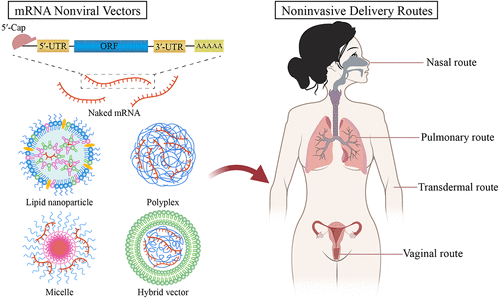当前位置:
X-MOL 学术
›
Acc. Chem. Res.
›
论文详情
Our official English website, www.x-mol.net, welcomes your
feedback! (Note: you will need to create a separate account there.)
Recent Advances in the Noninvasive Delivery of mRNA
Accounts of Chemical Research ( IF 16.4 ) Pub Date : 2021-11-10 , DOI: 10.1021/acs.accounts.1c00493 Ming Qin 1 , Guangsheng Du 1 , Xun Sun 1
Accounts of Chemical Research ( IF 16.4 ) Pub Date : 2021-11-10 , DOI: 10.1021/acs.accounts.1c00493 Ming Qin 1 , Guangsheng Du 1 , Xun Sun 1
Affiliation

|
Over the past two decades, research on mRNA-based therapies has exploded, mainly because of the inherent advantages of mRNA, including a low integration probability, transient expression, and simple and rapid in vitro transcription production approaches. In addition, thanks to improved stability and reduced immunogenicity by advanced strategies, the application of mRNA has expanded from protein replacement therapy to vaccination, gene editing and other fields, showing great promise for clinical application. Recently, with the successive launch of two mRNA-based COVID-19 vaccines, mRNA technology has attracted an enormous amount of attention from scientific researchers as well as pharmaceutical companies. Because of the large molecular weight, hydrophilicity, and highly negative charge densities of mRNA, it is difficult to overcome the intracellular delivery barriers. Therefore, various delivery vehicles have been developed to achieve more effective mRNA delivery. In general, conventional mRNA administration methods are based on injection strategies, including intravenous, intramuscular, intradermal, and subcutaneous injections. Although these routes circumvent the absorption barriers to some extent, they bring about injection-related concerns such as safety issues, pain, low compliance, and difficulty in repeated dosing, increasing the need to explore alternative strategies for noninvasive delivery. The ideal noninvasive delivery systems are featured with easy to use, low risks of infection, and good patient compliance. At the same time, they allow patients to self-administer, reducing reliance on professional healthcare workers and interference with bodily functions and daily life. In particular, the noninvasive mucosal delivery of mRNA vaccines can induce mucosal immune responses, which are important for resisting pathogens infected through mucosal routes.
中文翻译:

mRNA 无创递送的最新进展
在过去的二十年中,基于 mRNA 的疗法的研究呈爆炸式增长,主要是因为 mRNA 的固有优势,包括低整合概率、瞬时表达以及简单快速的体外转录产生方法。此外,得益于先进策略提高稳定性和降低免疫原性,mRNA的应用已从蛋白质替代疗法扩展到疫苗接种、基因编辑等领域,显示出巨大的临床应用前景。近期,随着两款基于 mRNA 的 COVID-19 疫苗的相继推出,mRNA 技术引起了科研人员和制药公司的极大关注。由于 mRNA 的分子量大、亲水性强、负电荷密度高,克服细胞内递送障碍是困难的。因此,已经开发了各种递送载体以实现更有效的 mRNA 递送。一般来说,传统的 mRNA 给药方法是基于注射策略,包括静脉内、肌肉内、皮内和皮下注射。虽然这些途径在一定程度上规避了吸收障碍,但它们带来了注射相关的问题,如安全问题、疼痛、依从性低和重复给药困难,增加了探索无创给药替代策略的必要性。理想的无创输送系统具有易于使用、感染风险低和患者依从性好的特点。同时,它们允许患者自行给药,减少对专业医护人员的依赖以及对身体机能和日常生活的干扰。特别是,mRNA 疫苗的非侵入性粘膜递送可以诱导粘膜免疫反应,这对于抵抗通过粘膜途径感染的病原体很重要。
更新日期:2021-12-07
中文翻译:

mRNA 无创递送的最新进展
在过去的二十年中,基于 mRNA 的疗法的研究呈爆炸式增长,主要是因为 mRNA 的固有优势,包括低整合概率、瞬时表达以及简单快速的体外转录产生方法。此外,得益于先进策略提高稳定性和降低免疫原性,mRNA的应用已从蛋白质替代疗法扩展到疫苗接种、基因编辑等领域,显示出巨大的临床应用前景。近期,随着两款基于 mRNA 的 COVID-19 疫苗的相继推出,mRNA 技术引起了科研人员和制药公司的极大关注。由于 mRNA 的分子量大、亲水性强、负电荷密度高,克服细胞内递送障碍是困难的。因此,已经开发了各种递送载体以实现更有效的 mRNA 递送。一般来说,传统的 mRNA 给药方法是基于注射策略,包括静脉内、肌肉内、皮内和皮下注射。虽然这些途径在一定程度上规避了吸收障碍,但它们带来了注射相关的问题,如安全问题、疼痛、依从性低和重复给药困难,增加了探索无创给药替代策略的必要性。理想的无创输送系统具有易于使用、感染风险低和患者依从性好的特点。同时,它们允许患者自行给药,减少对专业医护人员的依赖以及对身体机能和日常生活的干扰。特别是,mRNA 疫苗的非侵入性粘膜递送可以诱导粘膜免疫反应,这对于抵抗通过粘膜途径感染的病原体很重要。











































 京公网安备 11010802027423号
京公网安备 11010802027423号